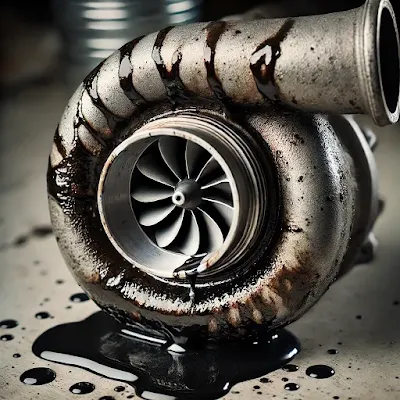The turbocharger is a crucial component in many modern vehicles, boosting performance by compressing the air entering the engine, which allows more power with a smaller engine displacement. However, the turbo is also one of the most delicate parts of the forced induction system and can get damaged for various reasons. As drivers, we need to understand how to care for the turbo and spot any signs of failure to avoid costly repairs.
Here, we’ll explore how a turbo can break, the symptoms of a possible malfunction, and finally, guide you step-by-step on how to replace a damaged turbo.
### How a Turbo Can Break and Common Causes
There are several ways a turbo can fail, whether due to natural wear or errors in maintenance or vehicle use. Below are some of the most common causes:
1. **Lack of Lubrication**: The turbo turbine spins at high speeds and requires continuous lubrication. Without a proper supply of oil, friction can damage the bearings, causing premature wear.
2. **Dirt and Contaminants**: Dust, particles, and contaminants in the air system can scratch the turbine blades or clog the oil lines.
3. **High Temperatures and Poor Cooling**: Ineffective cooling can lead to overheating, damaging the internal components of the turbo. Insufficient cooling may result from issues in the cooling system or the habit of turning off the engine immediately after heavy use, which prevents the turbo from gradually cooling down.
4. **Power Boosting**: Increasing turbo pressure or power without proper adjustments can put excessive load on the turbo, shortening its lifespan.
5. **Driving Errors**: Frequent hard acceleration and deceleration, as well as overuse of the turbo while the engine is cold, can cause premature fatigue.
### Symptoms of a Damaged Turbo
A damaged turbo usually presents several symptoms that indicate something is wrong. Paying attention to these signs can help prevent major failure. Some of the most common symptoms are:
- **Loss of Power**: The engine seems less efficient, and power decreases because the turbo cannot pressurize the air properly.
- **Blue or Black Smoke**: A damaged turbo may burn oil, producing blue smoke, or burn an incorrect air-fuel mix, producing black smoke.
- **Unusual Sounds**: If you hear a high-pitched noise, a whistling, or an excessive hum, it could indicate that the turbine blades are damaged or the bearings are worn out.
- **Excessive Oil Consumption**: An oil leak in the turbo can increase the engine's oil consumption, as the turbo requires oil for lubrication.
### How to Sense When a Turbo Is About to Fail
Generally, if you experience any of the symptoms above, especially excessive whistling or power loss, you should have the turbo inspected as soon as possible. Also, if you notice a loss of turbo pressure or an unusual increase in oil consumption, it could be an early warning sign of issues.
## Step-by-Step Guide: How to Replace a Turbo in Your Vehicle
Replacing a turbo requires skill and attention to detail, so make sure you have the right time and tools before starting.
### Tools Needed
- Set of wrenches and screwdrivers
- Torque wrench
- Screw extractor (if needed)
- Personal protective equipment
- New gasket for the turbo
- New oil supply (according to engine specifications)
- New turbo compatible with your car model
### Replacement Procedure
1. **Preparation**: Ensure the engine is completely cool before starting. Disconnect the battery to avoid any electrical accidents.
2. **Removing the Damaged Turbo**:
- **Disconnect the Air System**: Remove the air intake and turbo outlet ducts. Be sure to label or remember the position of each hose to ease reassembly.
- **Disconnect the Oil System**: Loosen the turbo’s oil feed and drain lines. You may need a container to catch excess oil.
- **Remove Turbo Mounting Bolts**: Use a torque wrench to remove the bolts securing the turbo to the exhaust manifold. If they’re rusty or tight, use a screw extractor or apply some rust penetrant.
3. **Installing the New Turbo**:
- **Place the New Gasket**: Install a new gasket on the exhaust manifold to ensure a proper seal and avoid pressure leaks.
- **Mount the Turbo**: Fit the new turbo and secure it with the bolts, tightening them according to your vehicle’s torque specifications.
- **Reconnect the Oil Lines**: Connect the oil supply and drain lines, and check for any leaks.
- **Reconnect the Air Ducts**: Connect the air intake and outlet ducts. Ensure all hoses and clamps are properly tightened.
4. **Verification and Final Test**:
- **Refill Oil**: Check the engine’s oil level and top up if necessary. The new turbo requires an adequate oil supply from the start.
- **Start and Check the Engine**: Start the engine and let it idle for a few minutes, checking for any abnormal noise or oil leaks. Then, test the turbo under light driving conditions and listen for any strange sounds or signs of power loss.
### Conclusion
The life of a turbo depends as much on preventive care as on proper maintenance. Replacing a turbo may seem complicated, but with the right tools and following the steps mentioned, you can complete it successfully.


.jpeg)
